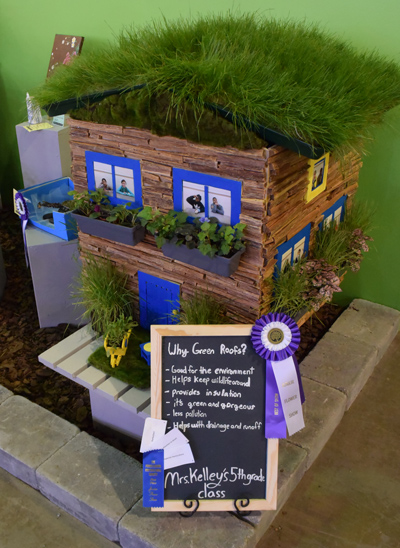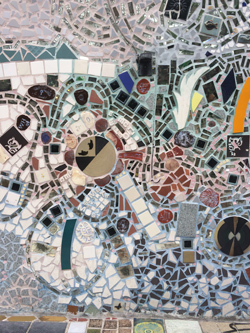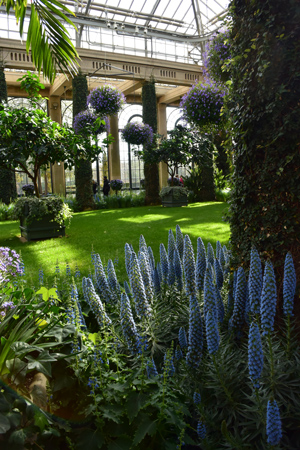![]()
Story and photos by Katie DeTar

Water features displayed at the March 2018 Philadelphia Flower Show
The Philadelphia Flower Show, one of the oldest and largest indoor garden shows in the world, brings the wow factor to the City of Brotherly Love every March. With more than 150 vendors, 4,500 exhibitors, and 300,000 square feet of display space, the event has inspired and delighted audiences since 1829. This year’s show continued the impressive horticultural feats while adding a renewed focus on conservation and environmental stewardship in the garden.
Woven amongst enormous multi-story floral displays, cascading waterfalls, and exotic and unusual plants were exhibits, how-to demos, and learning gardens meant to inspire the home gardener to protect, connect, and conserve resources in our own surroundings.

A bathtub repurposed as a backyard water feature
WATER PRESERVATION AND MEDITATION
Water is a powerful and essential life source and water features inject a sense of serenity and rejuvenation into the home garden. Something as simple as a bird bath or a small fountain calm the mind, create soothing sounds, attract birds, and create a meditative space at home
All of the gardens at the Philadelphia Flower Show featured water elements, playing off the 2018 theme, “Wonders of Water.” The quirkiest and most fun water feature was a repurposed claw foot bathtub filled with rainwater and displayed as a small pond. Engaging the theme from a conservation perspective, exhibits and seminars focused on water conservation, education, and reducing water use and waste in sound landscape design.

Backyard water and deck features on exhibit
One home option, permeable hardscape, allows for water drainage and reuse. The design options are many, including permeable asphalt or bricks/pavers or more open-set pavers or bricks with sand between. These all allow water to pass through them to be filtered into the soil and replenish underground aquifers. Permeable hardscapes also reduce flooding around patios and driveways.
A selection of plants considered to be “superheroes” for water protection can also help to reduce water runoff and filter storm water. Sugar maples draw water upwards from deep roots and deposit it in soil layers closer to ground level, reducing irrigation needs for surrounding plants. Scouring rush can stabilize stream and pond embankments and collect pollutants, keeping water resources clean for the community as a whole.

An example of permeable hardscape
XERISCAPING
Coined from the Greek word xeros, meaning dry, these are garden designs that require little to no irrigation or water beyond that found in the natural environment. While often we think of desert gardens, cactus, and succulents of the southwest to meet the xeriscape criteria, elements of xeriscaping can be implemented right here in New York State.
For home gardening, select plants that both adapt well to their native environments and thrive well with only the typical amount of rainfall for the region. Ornamental grasses and yucca both thrive in our climate and have low water needs. Juniper, lavender, rose of Sharon, and purple sage are other great options. Grouping together plants that require similar amounts of sun and moisture will help them thrive, and those that require the most water can be planted near downspouts or runoff areas to collect and filter rainwater and reduce the need for any irrigation. Mulching will also help retain moisture.
A high priority of xeriscaping is reducing the amount of turf that requires watering and fertilization. By limiting lawn space to that which is actually used for kids’ or pets’ play or foot traffic, we can reduce water usage. Changing our perception of what a home yard should be and look like—moving away from grass and into groundcover and low-maintenance gardens—could take some advocacy. Some homeowners associations, for example, prohibit xeriscaped yards and favor mowed grass. But with time and education, these types of gardens could become a simple, economical, and enjoyable way to landscape a home or commercial property.
CONSERVATION AND ENVIRONMENTAL PROTECTION

An educational exhibit on green roofs designed by students
Green roof displays and project demos encouraged homeowners to rethink the look and function of our home exteriors and invest in this environmentally conscious and beautiful home design. With the help of experienced installers, roofs are prepped with waterproofing to create a safe barrier between the home and the plantings. Slopes and drainage options are carefully considered. The roof plantings provide not only visual interest, but actually absorb carbon from the atmosphere, contain, filter, and reuse rainwater runoff, and provide the home with heating and cooling insulation. The initial cost of installation can be high but pays off over time with saved energy costs.
Garden displays also focused on and encouraged native plants and pollinator gardens. Coneflowers attract honeybees. Marigolds act as a natural pest repellant. Milkweed, butterfly weed, and flat-topped white aster all attract and provide pollen and nectar for butterflies while creating a natural wildflower look. Be sure not to use pesticides on these gardens in an effort to protect the bee and butterfly population they are designed to attract.

A pollinator garden
GARDENING FOR SMALL SPACES
As American living trends shift towards urban areas, yards have become smaller, and more compact living is in vogue. But this year’s show demonstrated that living smaller does not have to limit our gardening possibilities.
Porch and terrace facades showcased the endless creative possibilities for container gardens. Some grew tomatoes, herbs, and other vegetables in pots. Others hosted cacti, succulents, and mini rock gardens that require little water or maintenance. Many of these areas featured their own water elements, in the form of simple mini birdbaths or tiny fountains.

Hydroponic lettuce
Apartment living can also lead to a desire for community gardening, as displayed at this year’s show. Hydroponic lettuce was grown in a community greenhouse, while a small patch of land served as a shared vegetable garden and children’s exploratory garden. These greenspaces encourage neighborhood connection and healthy food choices.
Re-thinking our home garden design, examining what we find beautiful and natural, and creating a new era of functional beauty can protect our resources, invest in our future, and create wonderful gardens to enjoy for years to come.
Cheesesteaks and the Liberty Bell are not the only things that make this Eastern Seaboard city famous. Philadelphia is also known as American’s Garden Capital, and there are more than 30 public gardens located within 30 miles of downtown.From Japanese gardens to arboreta, sculpture parks to historic home gardens, there is a beautiful reason for every home gardener to visit Philadelphia. See americasgardencapital.org for more information. A few highlights include:
While not a plant-based garden, this quirky art space definitely is magical. Artist Isaiah Zagar, working over the course of eight years, filled vacant city lots with mosaics, found objects, mismatched pottery, and murals set amongst curving staircases and seating areas. When the landlord wanted to evict the artist—and the art—the community rose to save the space, founding an art-based nonprofit. 1020 South Street, Philadelphia. phillymagicgardens.org

Mosaics at Philadelphia’s Magic Gardens
Greensgrow Urban Farm
Greensgrow nonprofit urban farm offers a CSA (Community Supported Agriculture) program, a farm market, and special events for neighbors. Set in an urban neighborhood on once-industrial land, the farm began in hydroponics and expanded in an effort to feed the community and inspire others to get involved with local foods and gardens. The market offers local produce, meats, cheese, and specialty items, as well as event and community kitchen space. 2501 E. Cumberland Street, Philadephia. greensgrow.org
Longwood Gardens
This year-round, 1,077 acre estate is one of the premier garden destinations in the world, featuring special annual events and art-inspired flower and fountain displays. Founded by Pierre S. du Pont, the incredible expanse includes a four-acre indoor conservatory, woodlands, meadows, and seasonal displays. 1001 Longwood Road, Kennett Square, PA. longwoodgardens.org

The conservatory at Longwood Gardens
Katie DeTar is a freelance writer, television host, and creator of Fringe Benefits, a travel series airing nationally on PBS stations. Learn more at katiedetar.com.
Views: 0




